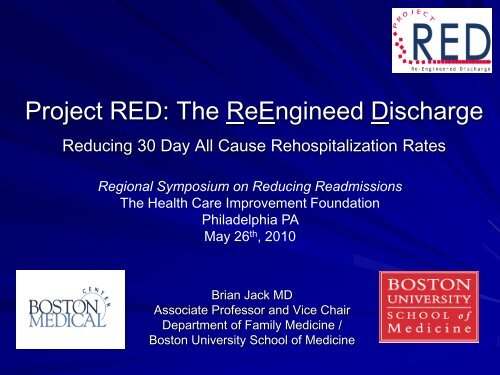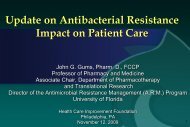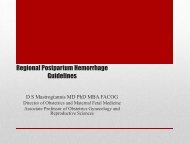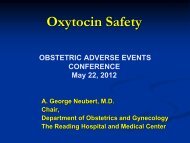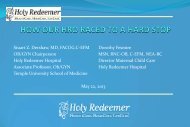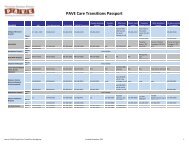Project RED The ReEngineed Discharge
Download (PDF, 8.23 MB) - Health Care Improvement Foundation
Download (PDF, 8.23 MB) - Health Care Improvement Foundation
- No tags were found...
Create successful ePaper yourself
Turn your PDF publications into a flip-book with our unique Google optimized e-Paper software.
<strong>Project</strong> <strong>RED</strong>: <strong>The</strong> <strong>ReEngineed</strong> <strong>Discharge</strong>Reducing 30 Day All Cause Rehospitalization RatesRegional Symposium on Reducing Readmissions<strong>The</strong> Health Care Improvement FoundationPhiladelphia PAMay 26 th , 2010Brian Jack MDAssociate Professor and Vice ChairDepartment of Family Medicine /Boston University School of Medicine
Plan for TodayI. <strong>The</strong> ProblemII.III.IV.How We Got StartedNQF „Safe Practice‟Is „Safe Practice‟ Safer?V. Risk Factors for RehospitalizationVI.Barriers to ImplementationVII. Roll-outVIII. Can Health IT Deliver?
“Perfect Storm”of Patient Safety<strong>The</strong> hospital discharge is nonstandardizedand frequentlymarked with poor quality.In 2006, there were 39.5 millionhospital discharges with coststotaling $329.2 billion!
Patients Are Not Prepared atAt <strong>Discharge</strong>:<strong>Discharge</strong>• 37% able to state the purpose of all theirmedications• 42% able to state their diagnosisPatients‟ Understanding of <strong>The</strong>ir Treatment Plans and Diagnosis at <strong>Discharge</strong>. Amgad N.Makaryus, MD, Eli A. Friedman, MD. Mayo Clinic Proceedings. August 2005; 80(8):991-994.
Little Time Spent on <strong>Discharge</strong>Audiotaped 97 discharge encounters8 Elements - Roter Interactional Analysis– Nurse, Pharmacist, Physician, Nurse Case ManagerAveraged 8 minutes (range, 2 to 28.5 min)No teachback 84% of the timePatient is a passive participant– Two initiated questionsNot comprehensive– 4 or fewer elements covered 50% of time
Documentation of Pending Testsin <strong>Discharge</strong> Summaries668 ptsDC summaries mentioned only 16% ofpending tests (482 of 2,927)All pts had at least 1 pending result, butonly 25% of dc summaries mentioned apending resultWere, MC et al. J Gen Internal Med 24(9):1002-6
Pending Tests Not FollowedAnnals of Internal Medicine. 2005; 143(2):121-8.• 41% of inpatients discharged with a pendingtest result• 37% actionable and 13% urgent• 2/3 of physicians unaware of results
Work-ups Not CompletedArchives of Internal Medicine. 2007;167:1305-11.25% of discharged patients requireadditional outpatient work-upsMore than 1/3 not completed
Communication Deficits at Hospital<strong>Discharge</strong> Are Common<strong>Discharge</strong> summary not readily available:• 12-34% at first post-discharge appt• 51-77% at 4 weeks<strong>Discharge</strong> summary lacking key components:•Hospital course (7-22%)• <strong>Discharge</strong> medications (2-40%)• Completed test results (33-63%)• Pending test results (65%)• Follow-up plans (2-43%)Direct communication, 3-20%Kripalani S, LeFevre F, Phillips CO, et al. Deficits in communication and information transfer betweenhospital-based and primary care physicians: implications for patient safety and continuity of care.JAMA 2007;297(8):831-41.
<strong>Discharge</strong>s are Variable by Day of the Week0.4 0.6 0.8 1.0MondayTuesdayWednesdayThursdayFridaySaturdaySunday0 20 40 60 80Days to Rehospitalization
Errors Lead to Adverse EventsArch Intern Med 2003;138:pp.19% of patients had a post-discharge AE1/3 preventable and 1/3 ameliorableCMAJ 2004;170(3):pp.• 23% of patients had a post-discharge AE• 28% preventable and 22% ameliorable
A Real <strong>Discharge</strong> Instruction Sheet
“Perfect Storm" of Patient Safety• <strong>The</strong> hospital discharge is non-standardized andfrequently marked with poor quality.Loose EndsCommunicationPoor Quality InfoPoor PreparationFragmentationGreat Variability• 20% of Medicare patients readmitted within 30 days 1• Only half had a visit in the 30 days after discharge 1Jenks NEJM 2009.
But it is More than Patient Safety"Hospitals with high rates of readmission willbe paid less if patients are readmitted to thehospital within the same 30-day period saving$26 billion over 10 years"Obama Administration Budget DocumentMedPAC recommends reducing payments tohospitals with high readmission ratesMEDPAC Testimony before Congress March „09http://www.hospitalcompare.hhs.gov/
Two QuestionsWe asked:Can improving the discharge processreduce adverse events and unplannedhospital utilization?Grant reviewer asked:What is the “discharge process”?
Principles of the <strong>RED</strong>:Creating the ToolkitReadmission Within6 MonthsHospital<strong>Discharge</strong>PatientReadmittedWithin3 MonthsProbabilisticRiskAssessmentProcessMappingFailure Modeand EffectsAnalysisQualitativeAnalysisRoot CauseAnalysis
<strong>RED</strong> ChecklistEleven mutually reinforcing components: Medication reconciliation Reconcile dc plan with National Guidelines Follow-up appointments Outstanding testsAdopted by Post-discharge servicesNational Quality Forum Written discharge plan What to do if problem arises as one of 30 Patient education"Safe Practices" (SP-11) Assess patient understanding Dc summary to PCP> Telephone Reinforcement
Should the NQF/<strong>RED</strong> be Donefor <strong>Discharge</strong> at Every Hospital?HypothesesA comprehensive discharge will:–Lower hospital utilization–Improve readiness for discharge–Increase PCP follow-up
Methods-Randomized Controlled TrialEnrollmentN=750Randomization<strong>RED</strong> InterventionN=375Usual CareN=37530-dayOutcome Data•Telephone Call•EMR ReviewEnrollment Criteria:•English speaking•Have telephone•Able to independently consent•Not admitted from institutionalized setting•Adult medical patients admitted to Boston Medical Center(urban academic safety-net hospital)
After Hospital Care PlanAfter HospitalCare Planfor:Maria Johnson<strong>Discharge</strong> Date: October 25, 2005
EACH DAY follow this schedule:Medication Schedule for Maria JohnsonWhat time of day doI take thismedicine?Picture(the medication fromthe pharmacy may notlook exactly like this)MedicationnameAmount# of pillsHow do I takethis medicine?Why am I takingthis medication?Motrin © (Ibuprofen)800mg 1 pillby mouth withfoodpainZestril © (Lisinopril)10mg 1 pillby mouthbloodpressureMorningApresazide © (HCTZ)25mg 1 pillby mouthbloodpressureNifedical XL © (Nifedipine)30 mg 1 pillby mouthbloodpressureProtonix © (Pantoprazole)40 mg 1 pillby mouthindigestion
Motrin © (Ibuprofen)800mg 1 pillby mouth withfoodpainNoonFlovent © (Fluticasone)44mcg/puff 2 puffsby inhalationthrough mouthhelpbreathingMotrin © (Ibuprofen)800mg 1 pillby mouth withfoodpainEveningFolic Acid1mg 1 pillby mouthvitaminBedtimeFlovent © (Fluticasone)44mcg/puff 2 puffsby inhalationthrough mouthhelpbreathingIf you need itfor anxietyAtivan © (Lorazepam)0.5 mg 1 pillby mouth1x each dayif neededanxietyProblem with anything in this packet?Call Your <strong>Discharge</strong> Advocate, RN – Lynn, Michael, or Mary: (617) 414-6822Serious health problem?Call your Doctor, Chris Manasseh: (617) 825-3400
After Hospital Care Plan Maria Johnson 10/11/05***Bring this Plan to each Appointment***MAIN PROBLEM:Chest PainAPPOINTMENTS:Monday, October 31 stat 1:30pmDr. Chris ManassehPrimary Care Physician(Doctor)at Harvard St. CommunityHealth Center John will driveFor a Follow-upappointmentOffice Phone #: 617-825-3400Tests:Lab test/Studies done in hospital. Waiting for results.Friday, November 4 that 10:00amDr. Sheilah BernardConsultant (Cardiologist)at Boston Medical Center;Doctor‟s Office Building -642 Take cab, use cabvoucherWednesday, November9 th at 9:30amNutritionistat Boston Medical Center Take #1 busTuesday, November15 th at 11:00amCardiac Stress Testat Boston Medical Center850 Harrison Ave4 th floor – CardiacStation John will drive; takeparking stickerFor a heart appointment To help with food plan To check your heartOffice Phone #: 617-638-7490Lab test/ study name Date done Name of clinician toreview/locationStomach biopsy fromendoscopy (stomachtest)October 24,2005Dr. Manasseh at Harvard StreetCHCOffice Phone #: 617-555-1234 Office Phone #: 617-555-2345Day/Date subject will see clinician to discussresults?Dr. Manasseh will talk to you about results atyour appointment with him on October 31, 2005.
November 2005***Bring this Plan to each Appointment***Sunday Monday Tuesday Wednesday Thursday Friday Saturday1 2 3 4 5Call cab at9:15amDr. Bernardat 10:00amat BMC6 7 8 9 10 11 12Cardiac StressTestat 11:00 amat BMCJohn will driveNutritionistat 9:30amat BMCTake #1 bus13 14 15 16 17 18 1920 21 22 23 24BMC will call at10am for study25 2627 28 29 30
How well did we deliver intervention<strong>RED</strong> ComponentIntervention Group (No,%)(N=370) *PCP appointment scheduled 346 (94%)AHCP given to patient 306 (83%)AHCP/DC Summary faxed to PCP 336 (91%)PharmD telephone call completed 228 (62%)* 3 subjects excluded from outcome analysis: subject request (n=2),died before index discharge (n=1)
What did we find?
Primary Outcome:Hospital Utilization within 30d after dcHospital Utilizations *Total # of visitsRate (visits/patient/month)ED VisitsTotal # of visitsRate (visits/patient/month)ReadmissionsTotal # of visitsRate (visits/patient/month)Usual Care(n=368)1660.451900.245760.207Intervention(n=370)P-value1160.314 0.009610.165 0.014550.149 0.090* Hospital utilization refers to ED + Readmissions
Cumulative Hazard RateCumulative Hazard Rate of Patients ExperiencingHospital Utilization30 days After Index <strong>Discharge</strong>0.0 0.1 0.2 0.3Usual careInterventionp = 0.0040 5 10 15 20 25 30Time after Index <strong>Discharge</strong> (days)
Self-Perceived Readiness for<strong>Discharge</strong>(30 days post-discharge)Usual C areR ED1009080706050%40302010Prep aredU nd erst andA p p t sU nd erst andM ed sU nd erst andDxQuest io nsanswered0
Outcome Cost AnalysisCost (dollars)Usual Care(n=368)Intervention(n=370)DifferenceHospital visits 412,544 268,942 +143,602ED visits 21,389 11,285 +10,104PCP visits 8,906 12,617 -3,711Total cost/group 442,839 292,844 +149,995Total cost/subject 1,203 791 +412We saved $412 in outcome costs for each patient given<strong>RED</strong>
Implications<strong>The</strong> components of the <strong>RED</strong> should beprovided to all patients as recommendedby the National Quality Forum,Safe Practice.
ErrorPatientMedication Issues Identifiedat 2-Day Post-dc Calldid not fillmoney/financial barrierintentional non-adherencenon-intentional non-adherencedid not fill, insurance issueSystem ProblemRx given w/ known allergiesconflicting info from different sourcesd/c instructions incomplete/inaccurateduplicationincorrect dosageincorrect quantitypt needed to fill at special pharmacypt does not know how to useno Rx given at d/cFrequency,number (%)n=19716 (3.5)19 (4.1)170 (36.7)57 (12.3)18 (3.9)3 (0.6)111 (24.0)13 (2.8)14 (3.0)8 (1.7)2 (0.4)1 (0.2)2 (0.4)28 (6.0)Total errors 463 (100.0)
• Frequent Fliers• Health Literacy• Depression• Men• Substance Abuse• Elderly• LOS• Co-morbidityWho is at risk ofRehospitalizations?
Risk of re-utilizationHEALTH LITERACY: Risk of hospital re-utilization0 10 20 30 40 50 60Usual CareInterventionp=0.06 p=0.59 p=0.38 p=0.04Grade 3 and below Grade 4-6 Grade 7-8 Grade 9+REALM category
Elderly: Outcomes For Ages >=65yrs(121/738 Total Participants)Primary outcomes ≤30 days after index hospitalizationControln=60Interventionn=61P valueHospital utilizations, n (visits/patient/mo) 32 (0.53) 14 (0.23) 0.001Emergency department visits, n (visits/patient/mo) 12 (0.20) 2 (0.03) 0.01Readmissions, n (visits/patient/mo) 20 (0.33) 12 (0.20) 0.13Secondary OutcomesHow well were your questions answered before you leftthe hospital?How well did you understand your appointments afteryou left the hospital?15 (47%) 19 (76%) 0.0335 (73%) 44 (88%) 0.06
Depression: # Hospital Utilizations, HospitalUtilization Rate, and IRR at 30, 60 and 90 daysIRR = Incident Rate Ratio
Risk Factors for Rehospitalization in TwoDatasets: <strong>RED</strong> and NHIS, 2007
True positive rate0.0 0.2 0.4 0.6 0.8 1.00 0.18 0.37 0.55 0.74 0.92Receiver Operating Characteristics Curves: Logistic Mixed EffectsRegression and Simple Risk Score Models for <strong>RED</strong> and NHIS dataFigure 1: Receiver Operating Characteristics Curves: Logistic Mixed EffectsRegression and Simple Risk Score Models for <strong>RED</strong> and NHIS dataMixed Effects-Logistic <strong>RED</strong>AUC<strong>RED</strong>: Mixed Effects 0.95NHIS: Mixed Effects: 0.870.0 0.2 0.4 0.6 0.8 1.0False positive rate
<strong>RED</strong> Effectiveness for RiskStratified GroupsRisk factors included in the analysis are: gender, marital status, depression status,hypertension/diabetes/asthma status, “frequent flier” status, and homelessness
Why Hospitals Should Use <strong>RED</strong>• Volume– Opens Beds by decreasing 30 day re-hospitalization/ED use by 30 percent– Improves PCP follow-up• Satisfaction– Improves satisfaction of patients and their families– Improves community image– Brands the hospital with high quality• Safety– National Quality Forum Safe Practice– Safe practice endorsed by IHI, Leapfrog, CMS, TJC– Exceeds Joint Commission standards– Improves patient “readiness for discharge”– Documents the discharge teaching and preparation– Documents patient understanding of the plan• Cost - the business case– Saves $412 per subject enrolled– Allows physicians to bill higher discharge level– Reduces diversion and creates greater capacity for higher revenue patients– Improves relationships with ambulatory providers*– Improves market share as “preferred provider”– Prepares for change in CMS rules regarding readmission reimbursement
Dissemination• Website diagnostics - Thousands of worldwide contacts• PR - AHRQ webinar - 2,200 hospitals signed up• AHRQ Roll –out– 6 hospital beta sites across country– Studying the process of implementation• Joint Commission, AMA, State Hospital Assns, KP etc.• Office of Tech Transfer at BU– 132 hospitals now actively engaged• AHA - H2H• CMS: 14 QIO - “Safe Transitions”• IHI Commonwealth Fund - STARS• Society Hospital Medicine - BOOST
Can Health IT assist withproviding a comprehensivedischarge?
Using Health IT to OvercomeChallenge of RN TimeEmbodied Conversational Agents• Emulate face-to-face communication• Develop therapeutic alliance using empathy,gaze, posture, gesture• Teach <strong>RED</strong>• Determine Competency• Can drill down• Maps of CHCs• High Risk MedsLovenoxInsulinPrednisone taperCharacters: Louise (L) and Elizabeth (R)
Studies of Nurse-PatientInteraction
Workstation for Data Entry
Automated <strong>Discharge</strong> Workflow
Patient Interacting with Louise
Embodied Conversational Agenthttp://relationalagents.com/red_demo_4545.wmv
Pilot Study: Self-Report Ratingsof the Virtual Nurse (mean (SD))Rating ScaleStudyQUESTION1 7 First SecondHow satisfied were you with Louise not at all very 6.1 (1.2) 6.7 (0.7)How helpful was Louise? not at all very 6.7 (0.7) 6.5 (0.7)Was the information useful ? not at all very 6.5 (0.8) 6.6 (0.8)How friendly was Louise? not at all very 6.6 (0.7) 6.7 (0.7)How natural was talking to Louise? artificial natural 5.4 (1.7) 5.8 (1.7)How informative was Louise? not at all very 6.8 (0.6) 6.8 (0.5)How easy was talking to Louise? difficult easy 6.4 (1.4) 6.8 (0.7)How much do you trust Louise? not at all very 5.6 (1.4) 6.7 (0.8)How much do you feel that Louise cares about you? not at all very 5.4 (1.8) 5.8 (1.8)How did you feel about a computer character giving youhealth information?not at allcomfortablecompletelycomfortable 6.3 (1.1)Would you rather have heard the information from adoctor or nurse?definitely preferdoctor or nursedefinitely preferElizabeth/Louise 5.4 (1.9)How much did you feel that your talk with Louise helpedyou get ready to leave the hospital? not at all very 6.5 (0.8)
Who Would You Rather Receive<strong>Discharge</strong> Instructions From?Nurse 10% Either 16%Agent 74%“I prefer Louise, she‟sbetter than a doctor, sheexplains more, anddoctors are always in ahurry.”“It was just like a nurse,actually better, becausesometimes a nurse justgives you the paper andsays „Here you go.‟Elizabeth explainseverything.”
Agents Could Be MoreEffective Than People1. Relies minimally on text2. Enhances recall3. Provides redundant channels of information4. Listeners pay attention to gestures5. More flexible and effective than a videotaped lecture6. Individualized, consistent messages, every time7. Cost effective – less need for clinician time8. Easy-to-use9. No time limit10. Can assess competency and understanding
Online LouiseOngoing Work– Post-discharge web-based system designed toemulate the post-hospital phone callEnhance adherence– Medications– AppointmentsMonitor for adverse eventsRCT in-hospital Louise plus Online LouiseRCT of Patients with Depressive Symptoms
ConclusionsHospital <strong>Discharge</strong> is low hanging fruit forimprovement<strong>RED</strong> is NQF Safe Practice<strong>RED</strong>:– Can be delivered using AHCP tool– Can decreased hospital use30% overall reductionNNT = 7.3Saves $412 per patientHealth IT Could Help– could improve delivery– further improve cost savings and build thebusiness case
Thank you!Brian Jack brian.jack@bmc.org<strong>Project</strong> <strong>RED</strong> Websitehttp://www.bu.edu/fammed/projectred/Engineered Care Websiteinfo@engineeredcare.com
GENDER: Primary outcomes ≤30days after index hospitalization
GENDER: Outcome data collectedat 30-day follow-up call by gender


